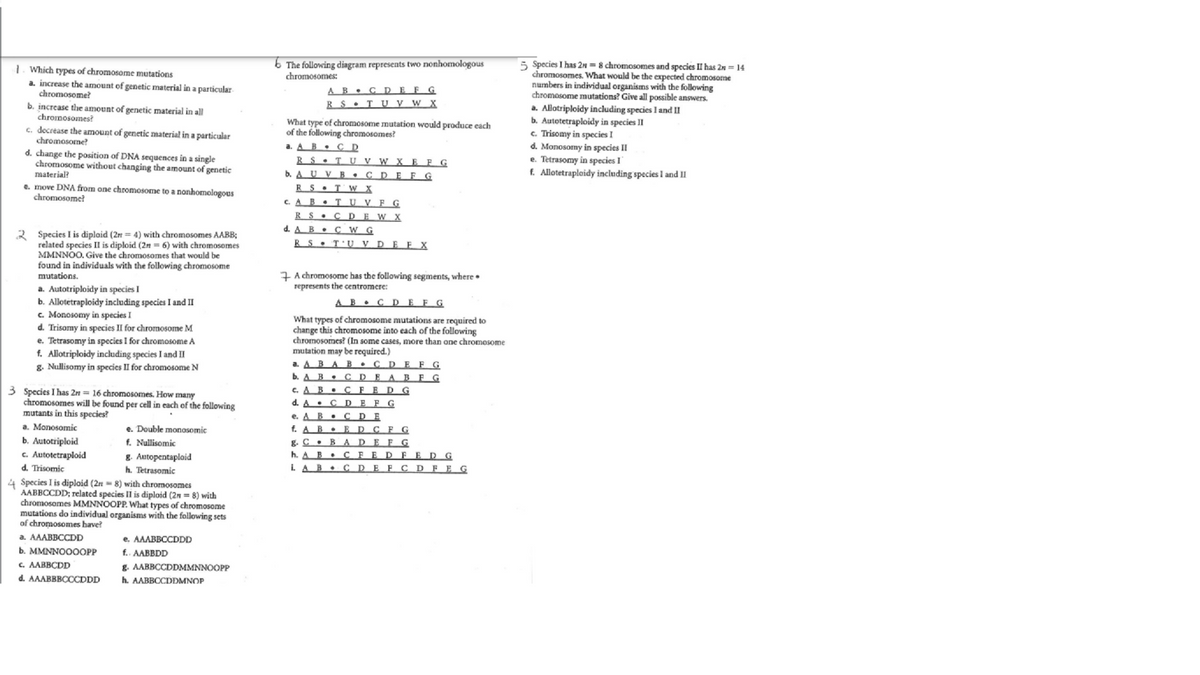hich types of chromosome mutations increase the amount of gonetic materiallea particular chromosemet increase the ameent of genetic material in all chronosomest decrease the amouat of geetic material in a particular hromosome hange the position of DNA seguences in a single chromoseme without changing the amount of getic material? move DNA fom one choomosorse to a nonhomelnges hromosomet Species I is diplaid (2n= 4) with chromosomes AABB: related species Il is diploid (2n-6) with chromosemes MMNNOO. Give the chromosomes that would be found in individuals with the followring chromesome mutations.
hich types of chromosome mutations increase the amount of gonetic materiallea particular chromosemet increase the ameent of genetic material in all chronosomest decrease the amouat of geetic material in a particular hromosome hange the position of DNA seguences in a single chromoseme without changing the amount of getic material? move DNA fom one choomosorse to a nonhomelnges hromosomet Species I is diplaid (2n= 4) with chromosomes AABB: related species Il is diploid (2n-6) with chromosemes MMNNOO. Give the chromosomes that would be found in individuals with the followring chromesome mutations.
Biology: The Dynamic Science (MindTap Course List)
4th Edition
ISBN:9781305389892
Author:Peter J. Russell, Paul E. Hertz, Beverly McMillan
Publisher:Peter J. Russell, Paul E. Hertz, Beverly McMillan
Chapter22: Speciation
Section: Chapter Questions
Problem 6TYK
Related questions
Question

Transcribed Image Text:6 The following diagram represents two nonhomologous
chromosomes:
5 Species I has 2n = 8 chromosomes and species II has 2n = 14
chromosomes. What would be the expected chromosome
numbers in individual organisms with the following
chromosome mutations? Give all possible answers.
a. Allotriploidy including species I and II
b. Autotetraploidy in species II
c. Trisomy in species I
d. Monosomy in species II
1. Which types of chromosome mutations
a. increase the amount of genetic material in a particular
chromosome?
AB • C D E F G
RS •TU y w x
b. increase the amount of genetic material in all
chromosomes?
c. decrease the amount of genetic material in a particular
chromosome?
d. change the position of DNA sequences in a single
chromosome without changing the amount of genetic
What type of chromosome mutation would produce each
of the following chromosomes?
a. A B• C D
R $ • T U V W X E F G
b. AU V B • C DE F G
R S •TW X
e. Tetrasomy in species I
f. Allotetraploidy including species I and II
material?
e. move DNA from one chromosome to a nonhomologous
chromosome?
C.AB•T U V F G
R S •C D E W X
d. A B • C W G
RS •T'U V D E F X
2 Species I is diploid (2 = 4) with chromosomes AABB;
related species II is diploid (2n = 6) with chromosomes
MMNNOO. Give the chromosomes that would be
found in individuals with the following chromosome
mutations.
7 A chromosome has the following segments, where•
represents the centromere:
a. Autotriploidy in species I
b. Allotetraploidy including species I and II
c. Monosomy in species I
d. Trisomy in species II for chromosome M
e. Tetrasomy in species I for chromosome A
f. Allotriploidy including species I and II
g. Nullisomy in species II for chromosome N
AB • CDEFG
What types of chromosome mutations are required to
change this chromosome into each of the following
chromosomes? (In some cases, more than one chromosome
mutation may be required.)
a. A BAB • C D EF G
b. A B • C D EA BFG
c. A B • C FED G
d. A• C D E F G
e. A B • C D E
f. A B • ED CFG
g. C • B A D E F G
h. A B• C F ED F EDG
I. A B • C DEFC D F E G
3 Species I has 2n = 16 chromosomes. How many
chromosomes will be found per cell in each of the following
mutants in this species?
a. Monosomic
ь. Аutotriploid
c. Autotetraploid
d. Trisomic
e. Double monosomic
f. Nullisomic
g. Autopentaploid
h. Tetrasomic
4 Species I is diploid (2n - 8) with chromosomes
AABBCCDD; related species II is diploid (2n = 8) with
chromosomes MMNNOOPP. What types of chromosome
mutations do individual organisms with the following sets
of chromosomes have?
a. AAABBCCDD
b. MMNNOOOOPP
e, AAABBCCDDD
f.. AABBDD
c. AABBCDD
g. AABBCCDDMMNNOOPP
h. AABBCCDDMNOP
d. AAABBBCOCDDD
Expert Solution
Step 1
Mutation is an abrupt change in the DNA sequence. It may increase or decrease a particular trait governed by that mutation.
Kindly post remaining questions as fresh questions as we are allowed to do first full question or first three sub parts.
Step by step
Solved in 2 steps

Knowledge Booster
Learn more about
Need a deep-dive on the concept behind this application? Look no further. Learn more about this topic, biology and related others by exploring similar questions and additional content below.Recommended textbooks for you

Biology: The Dynamic Science (MindTap Course List)
Biology
ISBN:
9781305389892
Author:
Peter J. Russell, Paul E. Hertz, Beverly McMillan
Publisher:
Cengage Learning

Biology (MindTap Course List)
Biology
ISBN:
9781337392938
Author:
Eldra Solomon, Charles Martin, Diana W. Martin, Linda R. Berg
Publisher:
Cengage Learning

Biology: The Dynamic Science (MindTap Course List)
Biology
ISBN:
9781305389892
Author:
Peter J. Russell, Paul E. Hertz, Beverly McMillan
Publisher:
Cengage Learning

Biology (MindTap Course List)
Biology
ISBN:
9781337392938
Author:
Eldra Solomon, Charles Martin, Diana W. Martin, Linda R. Berg
Publisher:
Cengage Learning